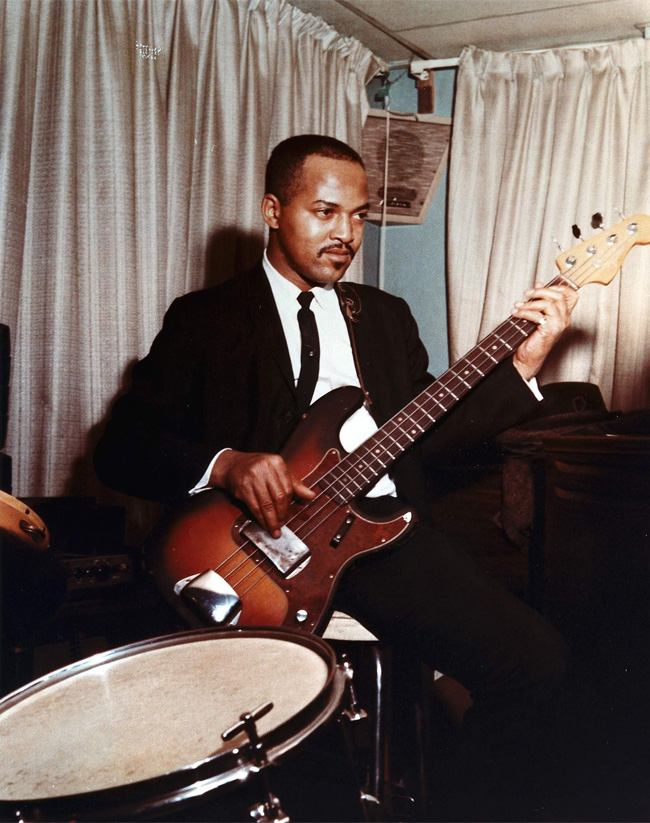The pinpoint-perfect syncopation. The melodic counterpoint. The ghost notes and inversions. In a foregone era when guitarists moonlit as four-stringers and walking bass lines reigned supreme, no bass player possessed the musical footprint of James Jamerson.
Motown’s golden-era recordings read like a lofty Jamerson resume: from sessions with Stevie Wonder to Marvin Gaye, The Supremes to the Four Tops. And with more No. 1 hits than The Beatles and The Rolling Stones combined, it’s a reputation that remains unsurpassed.

Despite the well-kept time capsule of recordings cementing the former Funk Brother’s legacy, the location of the gear Jamerson used to create them is largely unknown. And there is no mystique greater than that surrounding his notorious 1962 Fender Precision Bass, christened the Funk Machine.
Heard on the vast majority of Motown’s seminal tracks—“You Can’t Hurry Love,” “My Girl,” “What’s Goin’ On,” and “For Once in My Life,” just to name a handful—the Funk Machine was the weapon largely wielded by Jamerson in the shaping of the Motown Sound. Like much of his equipment throughout his lifetime, the Funk Machine was stolen and has never been found, leaving enthusiasts and historians forever bound on a quest to identify its whereabouts.
Of the basses Jamerson owned (and lost), the Funk Machine wasn’t his first.
Hard up for cash in his early Motown years, he’d borrow a metal upright bass from a local high school. And when fellow bassist Horace “Chili” Ruth bestowed him with his Fender Precision—a refinished ‘57 Precision dubbed the “Black Beauty”—he was reluctant to embrace it.
But Jamerson found the fretted fingerboard and smooth neck perfect for challenging passages at breakneck speeds. He’d eventually purchase his stalwart ‘62 after his bass (like much of his gear) was stolen—an event that no doubt cemented the new instrument as his session mainstay between 1966 and ’69.
A stark contrast to the music it created, the Funk Machine was as straightforward as they come: a production model with a double-cutaway alder body, three-tone sunburst finish, tortoiseshell pickguard, and chrome hardware and pickup covers. This could explain why Fender never created a signature model, as the instrument was left largely unchanged (though Fender does offer ‘62 Reissue Precision Basses that get impeccably close, along with some ‘60s-style Squier Vintage Modified models).
Reportedly, Jamerson did make one minor modification: He carved the word “funk” into the neck heel and colored it with blue pen ink.
Like the majority of Motown’s Funk Brothers, Jamerson came up as a jazz musician and, consequently, set up the Funk Machine to respond like an upright. He typically ran the bass with the volume and tone knobs set up as high as they’d go, using an Ampeg B-15 or a 2x15 Kustom amp in live performances, and famously going directly into the board during studio sessions with Motown’s specially made DI boxes. Jamerson would also insert a piece of foam as a string mute under the bridge cover to minimize the sustain of the instrument, the final ingredient of his signature plunk.
Also a testament to Jamerson’s remarkable hand strength and jazz upbringing, and famous, single-fingered “hook” plucking technique, the bass was equipped with La Bella heavy-gauge, flatwound strings. It’s said that the tension of his strings created a significant bow in the neck, to the point that the Funk Machine was essentially unplayable by anyone else other than Jamerson.
Then again, the instrument was never maintained to begin with. Jamerson never cleaned the bass or changed the strings, as he believed the residue was the key to his sound—or as he put it, “The gunk creates the funk.”

In the famed chronicling of Hitsville’s golden years, Dr. Licks’ Standing in the Shadows of Motown, Jamerson was said to have very sporadically dabbled in other equipment, including a Hagstrom eight-string, a Fender five-string and even some pedals—all of which he would soon abandon for the beloved, battle-worn Funk Machine.
Much like most of the lore surrounding the instrument, there are differing reports as to when the instrument was actually stolen. Popularly, the theft occurred days before his death in 1983, while others claim it disappeared before Jamerson (and Motown) moved to Los Angeles in the 1970s. But regardless, both signaled the decline from a period in which Jamerson and the Funk Machine were by and large one of music history’s most prolific influences on bassists from all walks.
The quest for the Funk Machine still remains, but there have been efforts to find the historic bass in recent years. One of the more public attempts came in 2014, when documentary filmmakers Paul Crutcher and Tom Neal started a Kickstarter campaign encouraging the crowdfunding of a formal investigation.
An even more recent resurfacing of Jamerson’s arsenal was in June 2017, when Heritage Auctions recovered and sold a Precision Bass Jamerson owned between 1962 and 1968 (nearly the same tenure as the mythical Funk Machine).
Claimed to have been a ‘62 by its former owner, Detroit bassist and Jamerson acquaintance Billy Hayes, the model was actually a ‘61 (though it was in all-original shape) and sold for $68,750. More important, however, was the fervor created in the gear community, inspiring bassists from all walks to resume the search for the Holy Grail of basses.
Looking for a Precision Bass of your own? Check out our Precision Bass Buying Guide.
